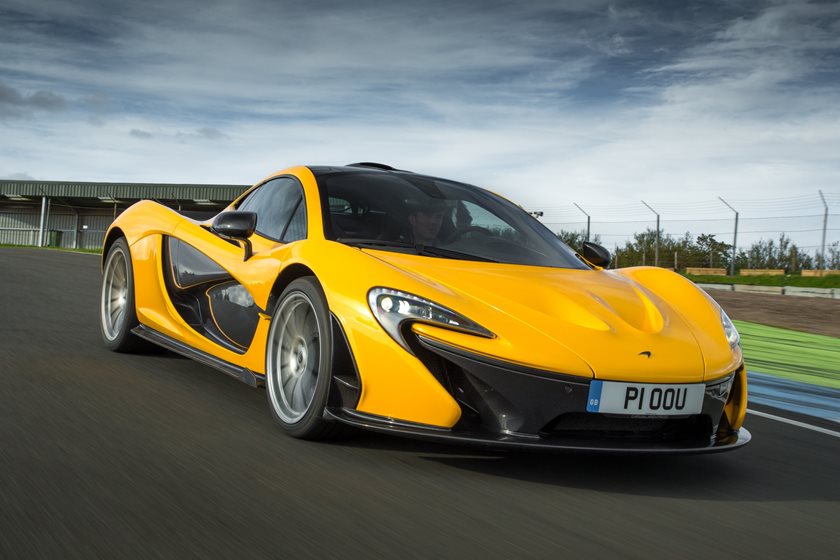by Chris Wall
The iconic McLaren F1 released in 1993 was an engineering marvel complete with a driver seat in the middle of the car and a gold plated engine bay, but with twenty years under its belt it was time for a new flagship model from the niche automaker. The modern successor couldn't just be another fast car with a fancy name and smooth lines, it had to raise the bar in the world of supercars and set new records, and so the McLaren P1 was born. With almost space age styling, an abundance of composite materials and a hybrid engine setup, the resulting package is a car worthy of the hypercar mantle that would adorn the walls of both children and adults alike in poster form. 903 horsepower will do that.
See trim levels and configurations:
| Trim | Engine | Transmission | Drivetrain | Price (MSRP) |
|---|---|---|---|---|
| P1 |
3.8L V8 Plug-in Hybrid
Plug-in Hybrid
|
7-Speed Dual Clutch
|
Rear-Wheel Drive
|
$1,350,000 |
It's not so much an interior as it is a cockpit in the McLaren P1. When you open the scissor door you're greeted with carbon fiber, more carbon fiber and a little more carbon fiber. Deep and high-bolstered race seats are covered in Alcantara, as is the top of the dash and the steering wheel along with a few select locations that need padding. The center of the dash connects to the transmission tunnel with smooth flowing lines and is home to the screen for the infotainment system. A second screen takes its place behind the steering where it does duty as a driver information center and configurable instrument cluster. There are a few places for storage of small items, but overall the look and feel is cold and dark, there's never any doubt that car is in charge here, not you. Visibility in the low-slung hypercar is good as long as you keep looking forwards.
The McLaren P1 is all about the drive, a very, very fast drive. You have the electric motor helping get the car off the line in the blink of an eye before the twin turbocharged gasoline engine takes over to propel the car forwards at such a rapid pace that an unsuspecting passenger might scream or throw up – or both. Other cars that offer similar performance, it's just that the P1 does it with drama and anger and violence. Steering is responsive to the point that you must pay careful attention to inputs and speeds; even with electronic help you can quickly have the rear try overtaking the front. The suspension is firm, even with E-mode and Normal drive modes selected, in Sport, Track or Race modes things get progressively harder and tighter. Letting the P1 choose it's own gears is best as it takes a while to get used to the paddle shifters, either way you have hard and fast shifts happening. Those deep seats keep you in place during hard cornering, the grip is phenomenal and with normal seats you'd bounce around the cockpit
The McLaren P1's performance had to set a new standard for gasoline / electric hybrids and it did what it set out to do. The P1 has a permanent-magnet synchronous electric motor that produces 177 hp and 96 lb-ft of torque, and that works together with a highly-tuned 3.8-liter V8 with twin-turbocharging working to produce an amazing 727 hp with 531 lb-ft of torque. The combination is mind-blowing – the P1 is rated at 903 hp. The hypercar reaches 60 mph in as little as 2.8-seconds and will hit 186 mph in 16.5-seconds. Top speed is 217 mph, oddly slower than the F1 though. A fast-shifting 7-speed dual clutch transmission helps direct all that power to the rear wheels.
The safety of the McLaren P1 is built into the car, and not really visible unless you know where to look. A carbon fiber MonoCage is the passenger compartment, safety cell and the major structural component for the chassis, a design taken from the company's Formula 1 exploits. The carbon fiber is five times stronger than top-grade titanium and twice as stiff as steel – and light too with the whole compartment weighing just 90kg. The only tech is the instrument cluster and the Android-based center screen for the infotainment that features a browser, maps, navigation, a media player, the phone and added apps.
The McLaren P1 was released in October of 2013 and by November all 357 units had been accounted for, making it arguably one of the best supercars money can buy, or could buy. It's the perfect combination of new technologies as far as the structure and the engine setup is concerned and ticks every single box someone interested in performance could ever want. There are faster cars available now, but they're never going to look or sound as good as the P1. The hypercar was created to prove the niche automaker still has what it takes to be a major player in the world of billionaire toys, and it's certainly proven itself.
The most popular competitors of McLaren P1:


